
There’s a new way game Twitter and gain followers that goes like this: perform searches for keywords and hashtags on topics of interest and then go about “liking” as many of these posts as possible in the hopes that those accounts will follow you.
There are some emerging tech tools that will automate part of this process – making it ever easier. An algorithm sifts through posts based on criteria you’ve selected – keywords or hashtags – and presents dozens of tweets at a time for your liking.
You don’t have to actually read these tweets, or the underlying links if there are any. Just simply like a bunch of them. You know that feeling you get when someone likes your tweets? That’s what you are doing here but at a manufacturing scale.
Some people I’ve spoken to swear this is a sound way to grow a Twitter audience and (ostensibly) gain online influence. To me, it’s a gimmick and such gimmicks on Twitter are about as old as Twitter itself.
The classic ploy is to follow a bunch of people knowing most will follow you back – and then secretly unfollow them a few days later. With just a little effort you’ll be able to grow a sizable following on Twitter.
More importantly, gamers believe, the number of people that follow you will, by all outward appearances, rapidly outpace the number of people you follow. The implicit message? Followers and ratios as a hallmark of online influence.
In reality, this is nothing more than a superficial fabrication.
As with the previous example, there are tools here too that will automate aspects of this technique as well, which arguably removes the “social” from social media.
More importantly, what is the value to the business and what is it that drives marketers to such ends?
More is Never Enough
At first glance, such words might sound technophobic, but they are not. I believe technology gives us leverage, but like Peter Thiel says in his book Zero to One, it works best when it augments humanity rather than replaces it.
There’s an old saying in public relations circles that you’re only as good as your last hit – you always need more placements. And that gets to the core of the point here – this is about the psychology of more in marketing: more content, more followers, and more leads.
It never ends. It is never enough.
As a result, marketing finds itself on the hamster wheel of more. Marketing rarely slows down to consider the impact or stops to analyze the results beyond the idea those metrics that suggest we are getting more.
And while it’s not always conscious or by design, sometimes, that leads us to gimmicks.
- We can create more content, but is it resonating? Time and time again, data has shown that most of us still skim content rather than read to the end. Perhaps time-on-page is a better digital metric than counting visitors.
- We can cultivate more followers, but is that the same thing as influence? Research shows 60% of people share links without reading. Perhaps measures of more meaningful engagement are better KPIs than the volume of shares.
- We can get more leads but of what quality? Perhaps there’s a better way to nurture or otherwise engage the respondent who registered to downloaded a white paper than having sales hit them up immediately with phone calls, voicemails and emails.
* * *
Maybe the metrics for more are right and they are working for your business. But the next time you feel the pressure for more, pause for a moment to consider: If we do get more does that help us meet the business goals?
Absent that pause marketing is on a hamster wheel where running faster looks industrious, but otherwise, doesn’t accomplish much. And that isn’t a whole lot different than the absurdity of gaming Twitter for followers.
Note: A version of this post was originally published on Sword and the Script under the title The Psychology of More in Content Marketing and Social Media.
Photo credit: Flickr, Ian Norman, Human Hamster Wheel (CC BY-SA 2.0)
